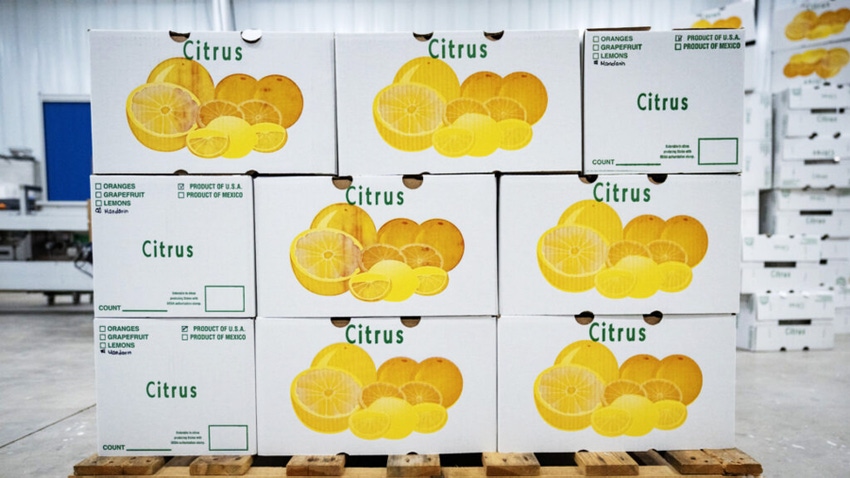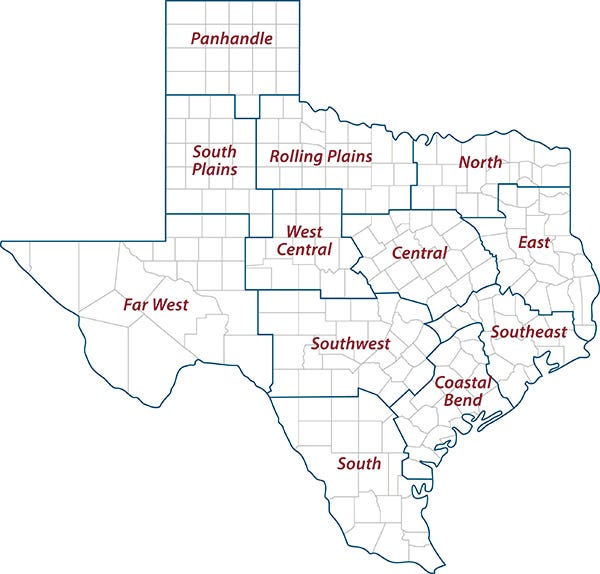February 20, 2024

The Texas citrus crop quality and quantity was better than expected following multiple seasons of weather-related setbacks, according to a Texas A&M AgriLife Extension Service expert.
Texas is the third largest citrus producer in the U.S., with the total economic impact of the citrus industry to the state exceeding $300 million annually. With increased fruit prices, cash receipts for citrus farmers recently exceeded $200 million.
The Texas citrus industry is almost completely located in the Lower Rio Grande Valley, with most of the acreage in Hidalgo County and the remainder Cameron and Willacy counties.
The industry has faced numerous challenges in recent years, including Hurricane Hanna in 2020, winter storm Uri in early 2021, and droughts in both 2022 and 2023. Even a few cold-weather snaps in mid-January of this year brought several hours of sustained below-freezing temperatures to the region.
Effects of winter storm Uri
After Uri, Texas grapefruit production was at about 1.6 million boxes for the 2021-2022 season, down 33% from the previous year’s final production of 2.4 million boxes. Orange production was about 400,000 boxes, down 62% from the previous year’s production.
Juan Anciso, Ph.D., AgriLife Extension vegetable specialist and associate head of the Department of Horticultural Sciences based at the Texas A&M AgriLife Research and Extension Center in Weslaco, said many producers have been worried there may be a repeat of Uri, so either they have decided not to replant citrus or have abstained from expanding their citrus acreage.
“The extended winter freeze of 2021 effectively decimated the citrus crop, losing 2,400-3,000 acres of the 24,000 acres of citrus planted that year,” Anciso said. “We were fortunate in that the few freezes we had earlier this year didn’t do any appreciable damage to the citrus crops.”
The current Rio Grande Valley citrus status
In spite of the challenges of recent years, Anciso said this year’s citrus crop production is looking up.
He said last year a total of 4.1 million fresh 40-pound boxes of grapefruit and oranges were produced, with 2.4 million boxes being grapefruit and the remainder being oranges.
“The 2023-2024 crop is off to a good start,” Anciso said. “We have already begun to harvest oranges and grapefruit, and the quality and yield are both looking really good at this point. There may be as much as a 20% increase over the last year’s production in these two crops.”
Other small-production citrus in the Rio Grande Valley, such as Persian limes and tangerines, appear to be unaffected by quality issues associated with last year’s drought, he said.
“There also has not been much of an issue with plant disease, including citrus greening, up to this point,” Anciso said. “The commercial citrus industry has taken an aggressive approach to curtailing citrus greening, and it looks like their efforts are paying off.”
What about water?
However, the crop's future will continue to depend on water availability. Citrus production is entirely dependent on the availability of irrigation water, which has been a longtime concern for the citrus industry in South Texas.
A recent report by Texas A&M’s Center for North American Studies, CNAS, analyzed the economic impact of the worst-case scenario of a complete absence of irrigation water in the Lower Rio Grande Valley.
Irrigation water shortages in the region have occurred since the 1990s and have been exacerbated since 1992 when Mexico began undersupplying the average minimum annual amount of water into the Rio Grande as required by a 1944 treaty.
“This water undersupply continues today,” said Luis Ribera, AgriLife Extension specialist in the Department of Agricultural Economics and CNAS director.
The water deficit for the current five-year cycle that began on Oct. 25, 2020 was 673,892 acre-feet as of Dec. 9. This represents the second largest irrigation water deficit in the last three decades.
“The past 30-plus years have demonstrated a trend toward fewer and fewer acre-feet of irrigation water available to the Lower Rio Grande Valley area,” Ribera said.
Ribera said irrigation continues to be a concern for citrus growers who have struggled to supply recovering citrus with adequate water and face uncertain water availability in the future.
The future of citrus in the Lower Rio Grande Valley
Dale Murden, president of Texas Citrus Mutual, an association representing citrus growers, said he estimates citrus production in the Lower Rio Grande Valley to be at only about 60% of what it was before Uri.
“We’re still trying to recover from the tree loss and damage from that winter storm, and many producers have been skeptical about replanting,” Murden said.
However, he said, this year things are looking good for the citrus industry.
“Citrus production is up, the current fruit quality is excellent, and prices have remained high, all of which are good for the producer,” he said.
Murden, who has been in the citrus industry long enough to remember the trials and tribulations of the past 40-plus years, said he is still optimistic about Texas citrus.
“Over the years, there have been issues with the weather, irrigation water and other challenges to the citrus industry, but in production agriculture you’ve got to be optimistic,” he said.
AgriLife Extension district reporters compiled the following summaries:

CENTRAL
The district received excellent rain and moisture and warm temperatures. Soil moisture was the best in a long time, but rainfall was not enough to produce running water to fill tanks and lakes. Producers started spring spraying of wheat with applications of fertilizer and insecticides. Some fieldwork was delayed by added soil moisture. Winter pastures improved and small grains were looking good. Some oats were killed due to the freezing temperatures, but most fields recovered. Producers prepared for spring planting as they fine-tuned and repaired planters and equipment. Farmers prepared for corn planting but were delayed due to rain. Wheat continued to be in fair to good condition. Excess soil moisture continued to be a concern for plant growth and development. Hessian flies remained a concern. Supplemental feeding was carried out for livestock. Cattle hay feeding became more difficult due to wet conditions.
ROLLING PLAINS
Overall, conditions across the district remained favorable. All areas received moisture in either rain or a rain/snow mix. Some counties reported 1-3 inches of rain and runoff that improved stock tank levels. Soil moisture conditions were favorable for spring wheat growth. Stocker calves were grazing wheat and appeared to be in good body condition.
COASTAL BEND
Recent rains improved soil moisture, yet poor rangeland and pasture conditions persisted due to extended drought. Winter grasses continued to grow, offering grazing opportunities for producers. Row crop producers prepared equipment and acquired seed for the upcoming planting season, but fields remained too wet for fieldwork. Soil moisture conditions were favorable for the approaching corn planting season. Sorghum plantings were expected to begin soon, although there were concerns about frost and rain. Ryegrass pastures provided needed grazing, and hay consumption decreased due to the emergence of winter annuals. Livestock producers faced hay shortages but continued feeding supplementation, with markets holding firm. Ponds filled up, offering optimism for the coming season.
EAST
Subsoil and topsoil conditions were adequate to surplus. Pastures and meadows were too wet for producers to feed or fertilize. Pasture and rangeland conditions were fair to poor. Lakes, ponds and creeks were full or overflowing with some areas reporting major flooding. Ryegrass was proceeding nicely. Livestock were in fair to good condition with dietary supplementation. Hay supplies were short, with some producers being completely out. Vultures were causing problems with calving in some areas. Wild pig activity increased.
SOUTH PLAINS
Approximately 3-4 inches of snow fell across the district, and there were 20-30 mph winds causing drifts. Temperatures warmed up quickly. Producers continued to prepare for the upcoming planting season and were hoping for more moisture. Cattle were in good condition.
PANHANDLE
The district received small amounts of snow and remained very dry. Some producers conducted preplant fieldwork. Dryland wheat continued to suffer from the lack of moisture. Supplemental feeding continued for cattle on rangeland. Soil conditions were very short to fair. Pastures and rangelands were in very poor to fair condition, and winter wheat conditions were poor to fair.
NORTH
Topsoil and subsoil were adequate to surplus for most counties. Pasture and rangeland conditions were fair to good for most counties. Pastures were progressing with all the nice weather, and temperatures reached the 70s over the past week. Rainfall kept the soil conditions very wet. Wheat and other cool-season crops were in excellent condition. The January freeze stunted growth and increased chlorosis in many fields, but most were recovering nicely. Wet conditions were slowing spring corn field preparations. Livestock were in good condition as producers continued supplemental feeding. Hay stocks in some areas were short due to low production. No significant insect or disease was reported.
FAR WEST
The district experienced mild weather, with temperatures of 30 degrees in the morning and 60 degrees in the afternoon. Small amounts of rain swept across the district, and warm, sunny days allowed producers to work on their fields. However, fields were already becoming powdery due to the lack of moisture. Most growers were not planning on starting irrigation until there was significant rain to start rebuilding the soil profile. Most producers had harvested and were pruning trees, as necessary. Ground preparation continued for cotton, alfalfa and possibly minimal vegetable acres. Livestock were in fair condition as producers continued supplemental feeding. Lambing and kidding season was in full swing.
WEST CENTRAL
Temperatures were in the mid- to upper 50s to lower 60s most of the week. Soil moisture was in good shape overall. Wheat and pasture conditions were improving. The January freeze caused some producers to lose their oats, but some fields recovered after recent rains and warmer temperatures. Fieldwork began for hay grazer. Lake and tank water levels remained low. Livestock producers continued heavy supplemental feeding for their herds. Local cattle markets remained strong.
SOUTHEAST
Small amounts of rain fell across the district, saturating pastures and spurring ryegrass and clover growth. The above-average temperatures improved wheat fields. Rainfall replenished stock tanks and ponds, and producers were preparing for corn planting. Prices in most classes of cattle held strong at local markets.
SOUTHWEST
Reported rainfall measurements reached nearly 1 inch. Recent rainfall provided adequate moisture, and grasses rebounded from the earlier freezing temperatures. Spring forbs were germinating due to replenished topsoil and mild temperatures. Additional moisture was still needed for cool-season vegetation. Irrigated wheat and oats continued to thrive. Corn and sorghum planting was expected to begin as soon as fields dried enough to allow access. Pasture conditions improved but rangeland conditions remained relatively poor. Spring lambing and kidding were underway, with livestock requiring significant supplementation but maintaining a fair condition overall.
SOUTH
Widespread rain ranged between 1.5-5 inches across the district. Producers began fieldwork for spring planting. Strawberry plants were putting on fruit and flowers. Citrus, sugarcane and other cool season crop harvests continued. Producers sprayed weeds. Field crops and rangelands were improving but could use more sunlight and warmer temperatures. The rainfall positively impacted wheat, oats and ryegrass. Producers continued to feed hay and supplements to livestock to maintain body condition. Prices at local sale barns remained strong and steady for all classes of beef cattle.
About the Author(s)
You May Also Like




